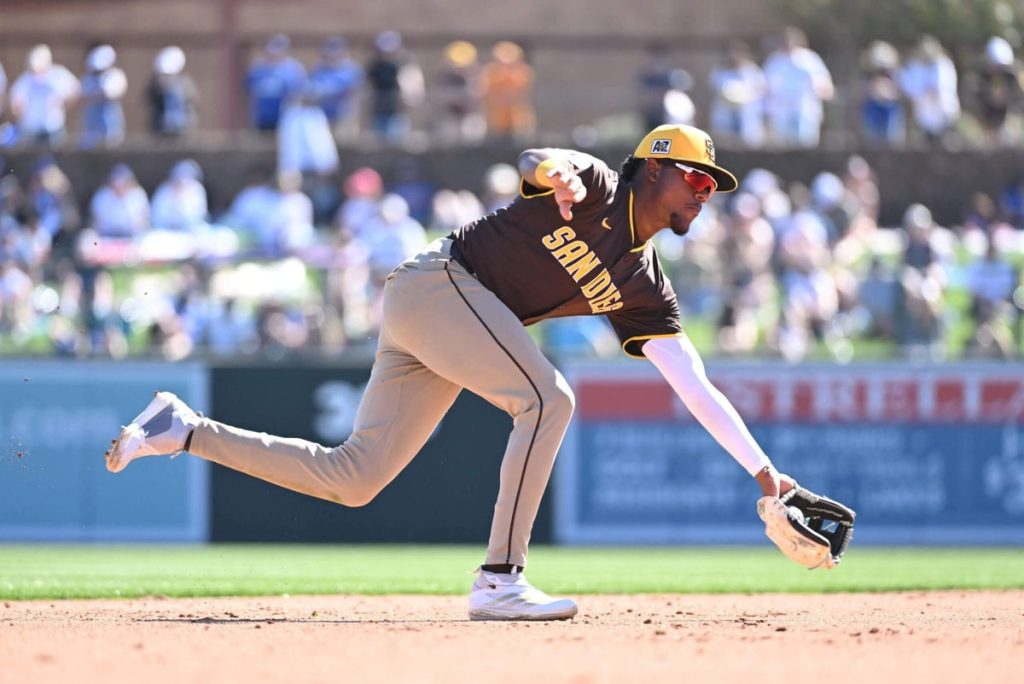Trade details: Padres acquire RHP Mason Miller and LHP JP Sears from the Athletics for SS Leo De Vries, RHP Braden Nett, RHP Henry Báez and RHP Eduarniel Nuñez.
The unstoppable A.J. Preller strikes again; he’d trade prospects he hasn’t even signed yet if the rules allowed it. The Padres dealt their top prospect, 18-year-old shortstop Leo De Vries, who is hitting reasonably well as the youngest regular in High A, plus three right-handed pitching prospects to the Athletics for reliever Mason Miller and starter JP Sears in a move that brings both pitchers to San Diego for 2026 and beyond — but we all know that’s not what Preller’s thinking about.
Miller has four years of team control remaining, and never has it mattered less for a pitcher. He’s got a long history of arm problems that forced him to the bullpen in 2024, where he’s been extremely effective while nearly always getting a day of rest between outings to try to protect his arm. He has averaged – averaged! – 101.1 mph on his four-seamer this season, while his slider is his best pitch, with huge tilt to it and velocity that tops out over 90 mph. He uses the same two pitches regardless of who’s at the plate, and this year lefties have gotten to him in a small sample after he showed no platoon split last year, hitting four homers, all on fastballs. It’s something to monitor, at least, but the sample is very limited.
He has one of the best arms in the sport, and as long as he stays healthy, he’ll help the Padres. If they try to start Miller again next year, though, I think that’s asking too much of him.
Sears has been much better for the A’s than I ever anticipated when they picked him up as part of the Frankie Montas trade with the Yankees — in fact, he’s been the best player they received by far, worth 2.5 fWAR/6.1 bWAR since the deal at the 2022 deadline. His stuff is pretty fringy across the board, but he throws a ton of strikes, and his sweeper limits hard contact despite the fact that he doesn’t get a ton of whiffs on it. Sacramento has crushed him this year, and he’ll probably see a boost to his superficial numbers just from moving to San Diego as his home field. His value is as much in his ability to soak up innings as anything else. The Padres have him for three more years.
The price the Padres paid was steep … but they might be the most win-now team in the sport at the moment, and I don’t think it’s as steep as it would appear at first glance.
Most of the value here is shortstop Leo De Vries, the No. 13 prospect on my midseason rankings, and the top guy in the Padres’ system at the moment, having passed the injured catcher Ethan Salas in everyone’s estimation. De Vries can hit, with good swings from both sides of the plate, showing real improvements this year in pitch and ball/strike recognition, and enough bat speed to get to good fastballs. He’s a true switch-hitter who makes more contact batting left-handed; his platoon split has flipped from 2024 to 2025, more evidence that one-year platoon splits are too noisy to be reliable, but his strikeout rates are more consistent and they’re lower when he’s batting from the left side.
De Vries has all of the physical ability to stay at shortstop, but I’ve gotten consistent reports this year that he’s looked bad on defense, to the point that other teams have questioned whether he’s going to stick at shortstop – and that has probably hurt his value. He could still end up an All-Star if he hits as expected, even at second base, but there’s obvious risk with any 18-year-old, and his ceiling’s a little lower if he has to move off short.
Signed as an undrafted free agent by San Diego in 2022, Braden Nett has made significant progress over the last year and a half, to the point where we can at least consider the possibility he’s a starter. His command has improved, and he’s gone from getting lit up against lefties to passable by junking his split-change, using a different grip for a true changeup to give him a viable option against left-handed hitters. He doesn’t have a clear plus pitch, instead working with five pitches that can all show above average, and if he pushes his control up another half-grade he could be a good fourth starter. Six months ago, I thought there was no way he could start due to the platoon issues and the command; I’d now put the odds closer to 50/50.
Right-hander Henry Báez is a sinkerballer with good control, getting groundball rates consistently over 50 percent, and he’s kept the ball in the park so far through Double A. He gave up just one run in his last four starts with the Padres over 21 innings, lowering his ERA on the season to 1.96, with an 8.1 percent walk rate that I’d like to see him bring down a little more, just because that’s how ground-ball guys stick as starters. He’s a sleeper.
Eduarniel Núñez is a righty specialist, going four-seamer/slider with nothing for lefties, but he’s punched out 42 percent of right-handed batters this year across three levels and allowed just a .091/.232/.190 line against them in 99 plate appearances. It’s a really strong return for the Athletics, especially if you believe, as I do, that Miller’s value could evaporate at any minute.
(Photo: Leo De Vries: Norm Hall / Getty Images)


